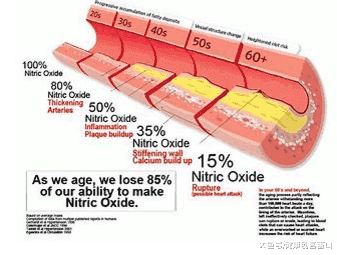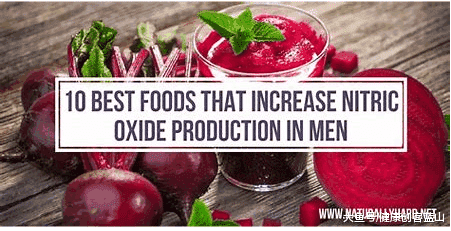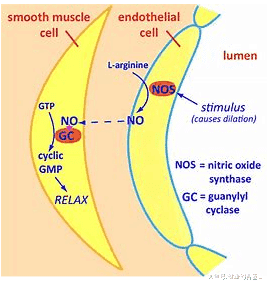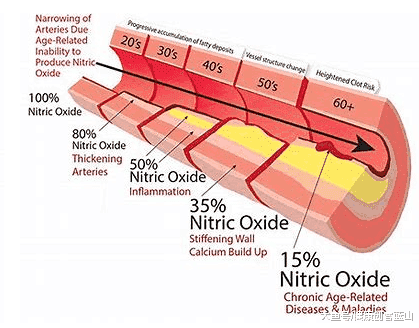5种自然增加一氧化氮的方法: 蔬菜、抗氧化剂、精氨酸瓜氨酸、少用漱口水使用和运动
5 Ways to Increase Nitric Oxide Naturally
一氧化氮是一种由身体自然产生的分子,它对健康的许多方面都很重要
一氧化氮是一种由身体自然产生的分子,它对健康的许多方面都很重要。
它最重要的功能是血管舒张,这意味着它可以放松血管内肌肉,使其扩张并增加循环。
一氧化氮的产生对整体健康至关重要,因为它能让血液、营养和氧气有效地进入身体的各个部位。
体内的一氧化氮水平岁年龄增长而降低
事实上,产生一氧化氮的能力有限与心脏病、糖尿病和勃起功能障碍有关。
幸运的是,有很多方法可以保持体内一氧化氮的最佳水平。
下面是5种自然增加一氧化氮的方法。
1.吃含高硝酸盐的蔬菜
如何增加一氧化氮
在某些蔬菜中发现的一种化合物硝酸盐,是蔬菜对人体健康的众多原因之一。
硝酸盐含量高的蔬菜包括(1):
芹菜
水芹
山萝卜
生菜
甜菜根
菠菜
芝麻菜
当这些食物被食用时,硝酸盐被转化为一氧化氮,它给心脏健康和运动表现带来了广泛的健康益处。
事实上,一些分析表明吃富含硝酸盐的蔬菜可以降低血压就像一些降压药一样(2,3,4,5)。
强有力的证据支持硝酸盐,尤其是来自甜菜根的硝酸盐有助于提高运动员的运动表现(6,7,8,9)。
尽管硝酸盐会影响体内一氧化氮的产生,有些人还是会避免使用,因为他们担心这些物质会对人体有害,并会导致癌症。
这可能是因为硝酸钠通常被用作熏肉、冷盘和热狗中的防腐剂和固定色剂。
吃这些食物会导致肠癌,硝酸盐被认为是罪魁祸首(10,11)。
硝酸盐能形成氨基 -亚硝基化合物,如亚硝胺,它们能引起癌症。
然而,占硝酸盐摄入量80%以上的蔬菜含有维生素C等抗氧化剂,有助于防止氨基-亚硝基化合物的形成(12)。
因此,蔬菜中的硝酸盐是无害的,而加工过的肉类中的硝酸盐会对健康造成危害,尤其是在长期过量食用时(13)。
蔬菜是硝酸盐的良好来源,有助于在体内形成一氧化氮。
总结
蔬菜是硝酸盐的良好来源,有助于在体内形成一氧化氮。食用富含硝酸盐的蔬菜可以改善心脏健康和锻炼表现。
2.增加抗氧化剂的摄入量
一氧化氮是一种不稳定的分子,在血液中迅速降解,因此必须不断补充。
增加其稳定性和限制其分解的一个方法是食用抗氧化剂。
抗氧化剂是一种能够中和自由基的分子,而自由基会导致一氧化氮的短暂寿命(15)。
这些抗氧化剂存在于所有食物中,但主要来源于植物,如水果、蔬菜、坚果、种子和谷物。
一些重要的抗氧化剂包括:
维生素C:这种抗氧化剂有助于身体形成结缔组织,包括皮肤、骨骼、肌腱和软骨。它还能产生帮助神经细胞交流的大脑化学物质。
维生素E:这种抗氧化剂可以保护细胞免受自由基的破坏,自由基被认为会导致衰老和疾病。它在保持免疫系统强壮方面也起着重要的作用(17,18)。
多酚类:这类抗氧化剂与一些健康益处有关,包括降低患癌症和心血管疾病的风险(19)。
一氧化氮由血管内皮细胞分泌
谷胱甘肽:创造了“所有抗氧化剂之母”,谷胱甘肽是人体每个细胞的主要抗氧化剂和解毒剂。
一些研究发现,摄入含抗氧化剂的一氧化氮前体,如硝酸盐或瓜氨酸,可以帮助减少一氧化氮的分解,从而保持体内一氧化氮含量更高(20,21,22,23)。
硝酸盐含量高的蔬菜本身也含有大量的抗氧化剂,这可能就是为什么蔬菜在增加和保持最佳一氧化氮水平时如此有效的原因(3)。
总结
抗氧化剂有助于减少分解,延长体内一氧化氮的寿命。
3.使用一氧化氮促进补充剂
一些膳食补充剂被称为“一氧化氮促进剂”。
这些补品本身不含一氧化氮,但它们包含的成分有助于在体内形成一氧化氮。
最常用的两种成分是L -精氨酸和L -瓜氨酸。
精氨酸
L-精氨酸是一种有条件的必需氨基酸,意味着它只需要在特定条件下在饮食中食用,而健康的成年人可以制造他们所需的一切(24)。
它通过L -精氨酸-无途径直接产生一氧化氮。
一些研究支持使用L -精氨酸来增加血液流量,但仅限于某些人群。
在高血压患者中,包括孕妇,L-精氨酸可以有效降低血压(25,26,27,28)。
然而,关于L-精氨酸改善健康个体血流或运动表现的证据仍然是混杂的(29,30,31,32)。
L -精氨酸在每天服用20克时通常被认为是安全的,但在服用10克时可能会引起消化症状(33,34)。
L-瓜氨酸
l -瓜氨酸是一种可有可无的氨基酸,意味着你的身体可以制造出它所需要的一切。
当L -精氨酸转化为一氧化氮时,L -瓜氨酸作为副产物产生。
然后,L-瓜氨酸可以回收到L-精氨酸中,用来增加人体的一氧化氮的自然生成。
事实上,L-瓜氨酸比补充L-精氨酸更能增加体内L -精氨酸的水平。这是因为大量的L-精氨酸在进入你的血液之前就被分解了(35)。
研究发现L-瓜氨酸可以增加血液流量,提高运动表现和降低血压(36,37,38,39)。
L -瓜氨酸被认为是相对安全的,并且有低的副作用风险,即使高剂量(40)。
总结
氨基酸l精氨酸和l -瓜氨酸是用来产生一氧化氮在你的身体。它们可以作为补充,对血管健康和血液流动有有益的影响。
体内的一氧化氮随年龄增长而减少
4. 限制漱口水的使用
漱口水可以消灭口腔内的细菌,这些细菌会导致蛀牙和其他牙齿疾病。
不幸的是,漱口水可以杀死所有种类的细菌,包括那些有助于产生一氧化氮的有益细菌。
口腔中的特殊细菌将硝酸盐转化为一氧化氮。事实上,如果没有这些细菌,人类就无法从硝酸盐中产生一氧化氮(41)。
研究表明,漱口水可以杀死产生一氧化氮12小时所需的口腔细菌(42,43)。
这导致一氧化氮的生成减少,在某些情况下,血压升高(44,45)。
漱口水对一氧化氮产生的有害影响甚至可能导致糖尿病的发生,其特点是胰岛素的产生或作用出现故障。
这是因为一氧化氮也调节胰岛素,胰岛素帮助细胞利用食物消化后的能量。没有一氧化氮,胰岛素就不能正常工作。
一项研究发现,每天至少用两次漱口水的人比从不用漱口水的人患糖尿病的可能性高出65%(46)。
因此,为了保持足够的一氧化氮产量,最好少用漱口水。
总结
漱口水可以杀死口腔中的多种细菌,包括有助于产生一氧化氮的细菌。这限制了身体产生一氧化氮的能力,而一氧化氮会导致高血压和糖尿病。
5。通过锻炼让你的血液流动起来
运动确实能促进血液循环,主要是因为它能改善内皮功能。
内皮细胞是指排列在血管内的薄薄一层细胞。这些细胞产生一氧化氮,维持血管健康。
一氧化氮生成不足会导致内皮功能障碍,导致动脉粥样硬化、高血压等心脏病的危险因素(47)。
运动通过增加身体产生一氧化氮的自然能力来保持内皮细胞和血管的健康。
一些研究表明,有规律的体育活动会增加高血压和心脏病患者以及健康人群的血管内皮舒张(48、49、50)。
研究还表明,运动可以增加抗氧化活性,这有助于抑制由自由基引起的一氧化氮分解(51,52)。
运动对内皮细胞健康和一氧化氮产生的好处可以在10周内看到,如果每周至少运动三次,每次30分钟(48次)。
为了获得最佳效果,把有氧训练(如散步或慢跑)和无氧训练(如阻力训练)结合起来。你选择的锻炼方式应该是你喜欢并且可以长期坚持的。
最后,和你的医生谈谈,看看你在锻炼方面有什么限制。
总结
经常锻炼可以改善内皮功能,从而促进一氧化氮的自然生成。
底线
一氧化氮是整体健康所必需的分子。一氧化氮作为血管舒张剂,向血管发出放松的信号,让血管扩张。
这种效果允许血液、营养和氧气自由流动到你身体的每个部位。但是当一氧化氮的生成减少时,你的健康就会受到损害。
因此,重要的是要达到并保持体内一氧化氮的最佳水平。
富含硝酸盐的蔬菜和抗氧化剂的饮食,或者补充如L -精氨酸或L -瓜氨酸,都是促进身体自然产生一氧化氮的有益方法。其他行之有效的策略包括限制漱口水和定期锻炼。
为了达到最佳的一氧化氮生成,每天至少运动30分钟,多吃富含一氧化氮的蔬菜。
5 Ways to Increase Nitric Oxide Naturally
Nitric oxide is a molecule that’s produced naturally by your body, and it’s important for many aspects of your health.
Its most important function is vasodilation, meaning it relaxes the inner muscles of the blood vessels, causing them to widen and increase circulation.
Nitric oxide production is essential for overall health because it allows blood, nutrients and oxygen to travel to every part of your body effectively and efficiently.
In fact, a limited capacity to produce nitric oxide is associated with heart disease, diabetes and erectile dysfunction.
Fortunately, there are many ways to maintain optimal levels of nitric oxide in your body.
Here are the top 5 ways to increase nitric oxide naturally.
1. Eat Vegetables High in Nitrates
How to Increase Nitric Oxide
Nitrate, a compound found in certain vegetables, is one of the many reasons vegetables are healthy for you.
Vegetables high in nitrate include (1):
Celery
Cress
Chervil
Lettuce
Beetroot
Spinach
Arugula
When these foods are consumed, nitrates are converted into nitric oxide, which confers a wide range of health benefits related to heart health and exercise performance.
In fact, several analyses have shown that eating nitrate-rich vegetables can lower blood pressure as much as some blood pressure medications (2, 3, 4, 5).
Strong evidence favors nitrates, especially from beetroot, for improving exercise performance in athletes (6, 7, 8, 9).
Despite the effects that nitrates have on nitric oxide production in your body, some people avoid them for fear they are harmful and contribute to cancer.
This is likely because sodium nitrates are commonly used as a preservative and color fixative in bacon, cold cuts and hot dogs.
Eating these foods is linked to bowel cancer, and nitrates are thought to be the culprit (10, 11).
Nitrates can form N-nitroso compounds, such as nitrosamine, which are capable of causing cancer.
However, vegetables, which account for more than 80 percent of nitrate intake, contain antioxidants like vitamin C, which help prevent the formation of N-nitroso compounds (12).
Therefore, nitrates from vegetables are harmless, whereas nitrates in processed meats can be troublesome to health, particularly when consumed in excess over long periods (13).
SUMMARY
Vegetables are good sources of nitrates, which help form nitric oxide in your body. Consuming nitrate-rich vegetables improves heart health and exercise performance.
2. Increase Your Intake of Antioxidants
Nitric oxide is an unstable molecule that degrades quickly in the bloodstream, so it must be constantly replenished (14).
One way to increase its stability and limit its breakdown is by consuming antioxidants.
Antioxidants are molecules that neutralize free radicals, which contribute to the short life of nitric oxide (15).
These antioxidants are found in all foods but primarily those of plant origin, such as fruits, vegetables, nuts, seeds and grains.
A few important antioxidants include:
Vitamin C: This antioxidant helps your body form connective tissues, including skin, bones, tendons and cartilage. It also produces brain chemicals that help nerve cells communicate (16).
Vitamin E: This antioxidant protects cells from the damaging effects of free radicals, which are thought to contribute to aging and disease. It also plays an important role in keeping the immune system strong (17, 18).
Polyphenols: This category of antioxidants is associated with several health benefits, including a reduced risk of cancer and cardiovascular disease (19).
Glutathione: Coined “the mother of all antioxidants,” glutathione is the master antioxidant and detoxifier of every cell in your body.
Several studies have found that ingesting nitric oxide precursors, such as nitrate or citrulline, with antioxidants maintains greater levels of nitric oxide in your body by helping reduce its breakdown (20, 21, 22, 23).
Vegetables that are high in nitrate are also inherently high in antioxidants, which is likely why vegetables are so effective at increasing and maintaining optimal levels of nitric oxide (3).
SUMMARY
Antioxidants help decrease the breakdown and extend the life of nitric oxide in your body.
3. Use Nitric-Oxide-Boosting Supplements
Several dietary supplements are marketed as “nitric oxide boosters.”
These supplements don’t contain nitric oxide itself, but they include ingredients that help form nitric oxide in your body.
Two of the most commonly used ingredients are L-arginine and L-citrulline.
L-Arginine
L-arginine is a conditionally essential amino acid, meaning it only has to be consumed in the diet under certain conditions, while healthy adults can make all they need (24).
It directly produces nitric oxide through a process called the L-arginine-NO pathway.
Several studies support the use of L-arginine for increasing blood flow, but only in certain populations.
In those with high blood pressure, including pregnant women, L-arginine is effective at lowering blood pressure (25, 26, 27, 28).
However, evidence on the ability of L-arginine to improve blood flow or exercise performance in healthy individuals remains mixed (29, 30, 31, 32).
L-arginine is generally recognized as safe when taking 20 grams per day, but it may cause digestive symptoms at dosages as low as 10 grams (33, 34).
L-Citrulline
L-citrulline is a dispensable amino acid, meaning your body can make all it needs.
When L-arginine is converted to nitric oxide, L-citrulline is produced as a byproduct.
L-citrulline can then be recycled back to L-arginine and used to increase your body’s natural production of nitric oxide.
In fact, L-citrulline increases levels of L-arginine in your body more than supplementing with L-arginine itself does. This is because a large percentage of L-arginine is broken down before reaching your bloodstream (35).
Studies have found L-citrulline to increase blood flow, improve exercise performance and lower blood pressure (36, 37, 38, 39).
L-citrulline is considered relatively safe, and there is a low risk of side effects, even with high doses (40).
SUMMARY
The amino acids L-arginine and L-citrulline are used to produce nitric oxide in your body. They are available as supplements and have beneficial effects on vascular health and blood flow.
4. Limit Your Use of Mouthwash
Mouthwash destroys bacteria in your mouth that can contribute to the growth of cavities and other dental diseases.
Unfortunately, mouthwash kills all types of bacteria, including the beneficial ones that help produce nitric oxide.
Special bacteria in the mouth convert nitrate to nitric oxide. In fact, humans cannot produce nitric oxide from nitrate without these bacteria (41).
Research has shown that mouthwash kills the oral bacteria needed to produce nitric oxide for up to 12 hours (42, 43).
This leads to a decrease in nitric oxide production and, in some instances, an increase in blood pressure (44, 45).
The detrimental effects of mouthwash on nitric oxide production may even contribute to the development of diabetes, which is characterized by malfunctions in insulin production or action.
This is because nitric oxide also regulates insulin, which helps cells utilize the energy obtained from food after it’s digested. Without nitric oxide, insulin cannot work properly.
One study found that people who used mouthwash at least twice daily were 65% more likely to develop diabetes than those who never used mouthwash (46).
Therefore, to maintain adequate nitric oxide production, it’s best to use mouthwash sparingly.
SUMMARY
Mouthwash kills many types of bacteria in the mouth, including the ones that help produce nitric oxide. This limits your body’s ability to produce nitric oxide, which can lead to high blood pressure and diabetes.
5. Get Your Blood Flowing With Exercise
Exercise really does get your blood pumping, largely because it improves endothelial function.
Endothelium refers to the thin layer of cells that line the blood vessels. These cells produce nitric oxide, which keeps blood vessels healthy.
Insufficient nitric oxide production results in endothelium dysfunction, which can contribute to atherosclerosis, high blood pressure and other risk factors for heart disease (47).
Exercise keeps your endothelial cells and blood vessels healthy by increasing your body’s natural ability to produce nitric oxide.
Several studies have shown that regular physical activity increases endothelial vasodilation in people who have high blood pressure and heart disease, as well as in healthy individuals (48, 49, 50).
Studies have also shown that exercise increases antioxidant activity, which helps inhibit the breakdown of nitric oxide caused by free radicals (51, 52).
The benefits of exercise on endothelial health and nitric oxide production can be seen in as little as 10 weeks when exercising for 30 minutes at least three times a week (48).
For optimal results, combine aerobic training, such as walking or jogging, with anaerobic training, such as resistance training. The types of exercise you choose should be things you enjoy and can do long term.
Finally, speak with your doctor to determine any limitations you may have in regards to exercise.
SUMMARY
Engaging in regular exercise can improve your endothelial function and thus your natural production of nitric oxide.
The Bottom Line
Nitric oxide is an essential molecule required for overall health. As a vasodilator, nitric oxide signals the blood vessels to relax, allowing them to expand.
This effect allows blood, nutrients, and oxygen to flow freely to every part of your body. But when nitric oxide production is decreased, your health can become compromised.
Therefore, it’s important to achieve and maintain optimal levels of nitric oxide in your body.
A diet high in nitrate-rich vegetables and antioxidants or the use of supplements, such as L-arginine or L-citrulline, are beneficial ways to boost your body’s natural production of nitric oxide. Other proven strategies include limiting mouthwash and exercising regularly.
For optimal nitric oxide production, increase your intake of nitrate-rich vegetables and exercise at least 30 minutes per day.
5 Ways to Increase Nitric Oxide Naturally https://www.healthline.com/nutrition/how-to-increase-nitric-oxide


.png)


.png)

.png)